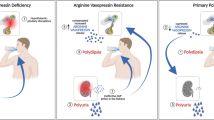Abstract
Evaluation and treatment of hyperglycaemic hyponatremia, being quantitatively inaccurate, is open to new advancements. We herein describe the improvement of previous calculations of glucose appearance (GA), solute and solvent changes. From GA we derive the predicted plasma sodium concentration (PNaG), assuming no change in total body water (TBW), but only water shift from cells to the extracellular space (ECV). This assumption is validated by the respective solute ratios (PCl/PNa) unchanged from normal values, as well as the ratios between actual and normal solute concentrations (PNa1/PNa0, PCl1/PCl0), identical for all solutes. When the assumption is met, GA can be exactly calculated. When the ratios are different from normal, they indicate the presence of a mixed abnormality due to a loss either of sodium, or sodium and water. These are estimated by computing the difference between PNaG and the actual PNa measured (PNa1). PNa1 ≈ PNaG if TBW and Na are unchanged, PNa1 < PNaG in the presence of prevalent Na depletion, PNa1 > PNaG when volume depletion prevails. In the first circumstance the ECV expansion is exactly established by appropriate mathematical formulas, in the latter conditions either Na or volume depletion are empirically estimated with algebric expressions. These equations were validated on computer-simulated models, and applied to 49 subjects with plasma glucose concentration >15 mM/L. GA and PNaG were computed, and, with the same formulas used in computer-simulated experiments, we calculated water and Na deficits. The PNa measured after correction of hyperglycaemia was correctly predicted (R 2 = 0.63, P < 0.0001). This method provides a firm ground to select the correct equation to accurately estimate the initial conditions of hyperosmolar hyperglycaemia, significantly improving its quantitative correction.





Similar content being viewed by others
Notes
SIAE registration number 0604311, information from: sonbartoli@libero.it, quoting reference program number 0606.
References
Arieff AI, Carroll HJ (1972) Nonketotic hyperosmolar coma with hyperglycemia: clinical features, pathophysiology, renal function, acid-base balance, plasma-cerebrospinal fluid equilibria and the effects of therapy in 37 cases. Medicine (Baltimore) 51:73–94
Bartoli E, Bergamasco L, Castello L, Sainaghi PP (2007a) A new method to distinguish the hyponatremia of electrolyte loss from that due to pure solvent changes. Eur J Appl Physiol. doi:10.1007/s00421-007-0488-6
Bartoli E, Guidetti F, Bergamasco L (2007b) Estimating excess glucose, sodium and water deficits in non-ketotic hyperglycaemia. Nephrol Dial Transplant. doi:10.1093/ndt/gfm427
Crandall ED (1974) Serum sodium response to hyperglycemia. N Engl J Med 290:465
Halperin ML, Bohn D (2002) Clinical approach to disorders of salt and water balance. Emphasis on integrative physiology. Crit Care Clin 18:249–272
Hillier TA, Abbott RD, Barrett EJ (1999) Hyponatremia: evaluating the correction factor for hyperglycemia. Am J Med 106:399–403
Katz MA (1973) Hyperglycemia-induced hyponatremia—calculation of expected serum sodium depression. N Engl J Med 289:843–844
Moran SM, Jamison RL (1985) The variable hyponatremic response to hyperglycemia. West J Med 142:49–53
Roscoe JM, Halperin ML, Rolleston FS, Goldstein MB (1975) Hyperglycemia-induced hyponatremia: metabolic considerations in calculation of serum sodium depression. Can Med Assoc J 112:452–453
Spira A, Gowrishankar M, Halperin ML (1997) Factors contributing to the degree of polyuria in a patient with poorly controlled diabetes mellitus. Am J Kidney Dis 30:829–835
Welt LG (1958) Concept of osmotic uniformity and the significance of hypo- and hypernatremia. Med Bull (Ann Arbor) 24:486–498
Author information
Authors and Affiliations
Corresponding author
Rights and permissions
About this article
Cite this article
Bartoli, E., Bergamasco, L., Sainaghi, P.P. et al. An improved method to compute the solute and water derangements of hyperglycaemia. Eur J Appl Physiol 102, 97–105 (2007). https://doi.org/10.1007/s00421-007-0561-1
Accepted:
Published:
Issue Date:
DOI: https://doi.org/10.1007/s00421-007-0561-1




